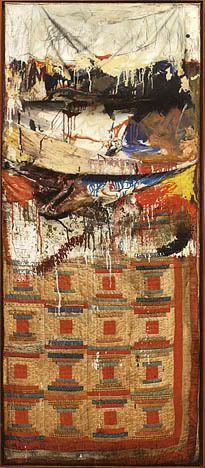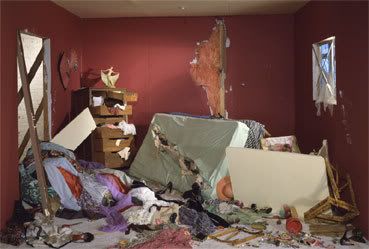Quote:
|
Originally Posted by demonrail666 (topic starter)
Bed is a far more conservative piece than Duchamp's, which questioned what could be permitted as art. Emin came along after that battle had largely already been won. Her piece is 'allowed' because of the earlier acceptance of his work, and that of Warhol, etc.) but uses it to return to a far more romantic view of the artist-as-social-outsider.
As such I always think that Bed has more in common with Van Gogh's (admittedly superior) Chair.
|
Really now? Van Gogh's chair?
 Robert Rauschenberg. Bed, 1955.
Robert Rauschenberg. Bed, 1955.
Combine painting
6'2" x 31 1/2" x 6 1/2"
Collection of Mr. and Mrs. Leo Castelli, New York
Following the charge of Duchamp (also Picasso's
Still Life with Chair Caning (everyone always forgets that specific one)) and in the wake of Abstract Expressionism, Robert Rauschenberg created several famous works (
Bed,
Monogram,
Canyon,
Coca-Cola Plan, etc.) in a "combine" style in which ordinary and found objects challenged the viewer's notion of what the picture plane is "supposed" to be and consist of.

Dylaby, 1962
And Rauschenberg directly asked the question in the early seventies with his series of cardboard "wall sculptures."
 ------------------------------------------------
------------------------------------------------
 Jeff Wall. The Destroyed Room, 1978
Transparency in lightbox 1590 x 2340 mm
National Gallery of Canada, Ottawa. Purchased 1988
Cinematographic photograph
Wall echoes Delacroix's composition (The Death of Sardanapalus, 1827-8), with its central sweeping diagonal and sumptuous palette of blood reds, while acknowledging its staged atmosphere by re-composing the scene as a roughly fabricated stage-set, (only in this case) absent of any players. 'Through the door you can see that it's only a set held up by supports, that this is not a real space, this is no-one's house,' he has commented. Though clearly a woman's bedroom, the cause of the violence is unexplained, leaving the viewer to speculate on the sequence of events.
While I don't feel Jeff Wall's work is all that incredible (and it's certainly not as revolutionary as Duchamp, Picasso, Warhol or Rauschenberg), its derivation and purpose is valid nonetheless. And the folks at the Tate Modern think the same.
Jeff Wall. The Destroyed Room, 1978
Transparency in lightbox 1590 x 2340 mm
National Gallery of Canada, Ottawa. Purchased 1988
Cinematographic photograph
Wall echoes Delacroix's composition (The Death of Sardanapalus, 1827-8), with its central sweeping diagonal and sumptuous palette of blood reds, while acknowledging its staged atmosphere by re-composing the scene as a roughly fabricated stage-set, (only in this case) absent of any players. 'Through the door you can see that it's only a set held up by supports, that this is not a real space, this is no-one's house,' he has commented. Though clearly a woman's bedroom, the cause of the violence is unexplained, leaving the viewer to speculate on the sequence of events.
While I don't feel Jeff Wall's work is all that incredible (and it's certainly not as revolutionary as Duchamp, Picasso, Warhol or Rauschenberg), its derivation and purpose is valid nonetheless. And the folks at the Tate Modern think the same.